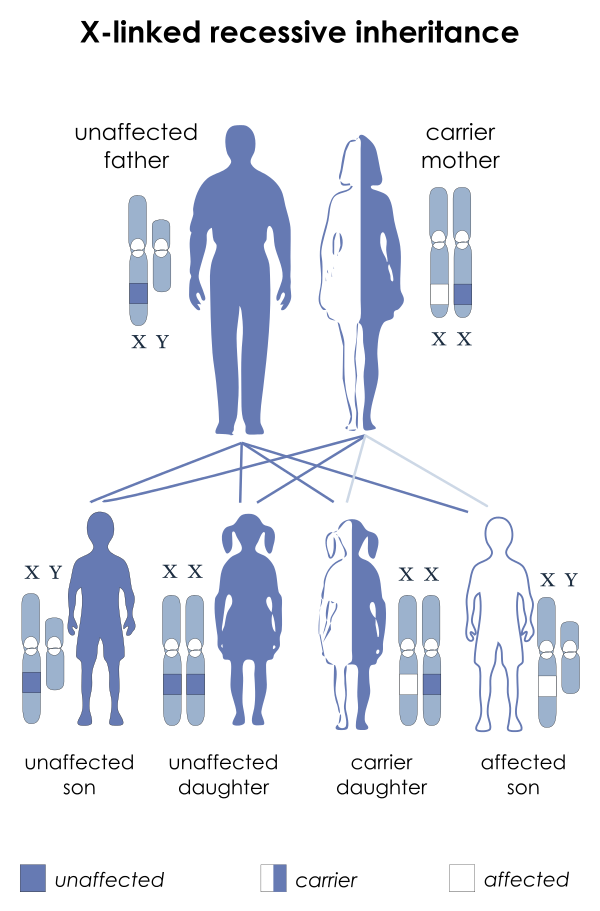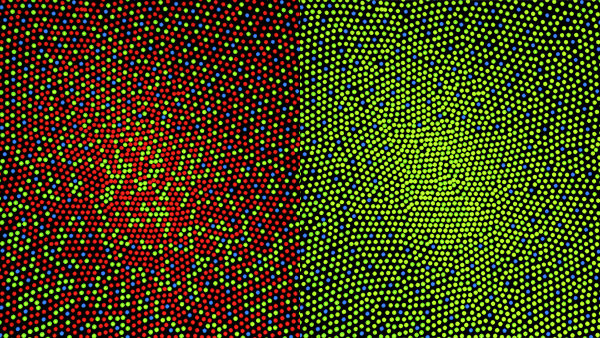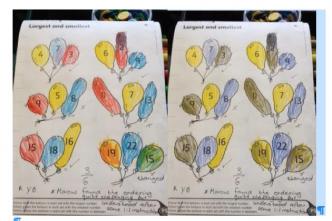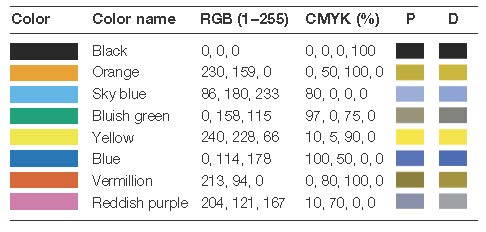Fifty shades of muddy green Understand article
To support children with colour vision deficiency in our classrooms, we have to understand their condition.

that men are more likely than
women to suffer from CVD.
Image courtesy of OpenStax
College; Image source:
Wikimedia commons
As we teachers become more aware of the ways in which some children are held back in school, one group of children that is often overlooked are those with colour vision deficiency (CVD), often referred to as colour blindness. CVD is the inability or decreased ability to see colour, or perceive colour differences, under normal lighting conditions. It is estimated that 1 in 12 boys and 1 in 200 girls suffer from some kind of CVD, which suggests there is at least one such child in every classroom.
There are different forms of CVD but all of them cause some difficulty with colour-related tasks, from playing in sports teams or filling in worksheets and maps, to refusing to eat something that looks particularly unappealing (Holmes, 2011). Many children adopt strategies to cope with CVD, so much so that as many as 80% leave primary school not knowing that they have this condition. As far as we can determine, primary schools across Europe do not routinely test pupils for CVD. Instead, children may be incorrectly labelled as lazy, disruptive or inattentive. Although most teachers know of colour blindness, few of us understand the real problems associated with it or have strategies to deal with students who have CVD.
What is CVD?
Colour blindness is usually a genetic condition that you are born with. The gene for red/green and blue colour blindness, which is carried on the X chromosome, is inherited from your parents. Because women have two X chromosomes, most women with the gene for colour blindness also have a healthy copy of the gene. Men, who have only one X chromosome, have no ‘spare’ healthy copy; this is why many more men are affected by colour blindness than women.
Not all CVD is inherited: some people acquire the condition as a result of chronic diseases such as diabetes, multiple sclerosis, some liver diseases and many eye diseases.

distribution of cone cells in
an individual with normal
colour vision (right), and a
colour-blind (protanopic)
retina (left). The centre of the
fovea holds very few
blue-sensitive cones.
Image courtesy of Mark
Fairchild
The retina at the back of the eye has two types of light-sensing cells: rods and cones. Rods detect light in low-light environments, like at night, and cones detect colour. When you look at an object, light enters your eye and stimulates both the rod and the cone cells. Your brain then interprets the signals from the cones so that you can see the colour of the object. Our eyes have three basic cones that are sensitive to different wavelengths of light. These cones are traditionally referred to as red, green and blue cones, because their sensitivity corresponds primarily to these colours, although they are actually sensitive to a wide range of colours. By combining the sensitivities of these cones, our optic system allows us to perceive different colours. For example, when the red and blue cones are stimulated in a certain way, you will see the colour purple.
The exact physical causes of colour blindness are still being researched but it is believed that colour blindness is usually caused by faulty cones or sometimes by a fault in the pathway from the cone to the brain.
Someone with CVD will have cones or pathways that function differently to someone with ‘normal’ sight. For example, someone with deficient red or green cones will see reds and greens as two very similar muddy green colours. People with red or green deficiencies will see the world in a similar way to each other because red and green are very close together on the light spectrum. This red/green deficiency is known as protanopia (a reduced sensitivity to red light) or deuteranopia (a reduced sensitivity to green light). These types of CVD could be particularly relevant when looking at ripe and unripe fruits, traffic lights, or marked schoolwork that uses red and green as a contrast.

shows what the child with
CVD drew, and the right is
what he saw, simulated by
Vischeck.
Image courtesy of David
Featonby
In figure 1, a 5-year-old pupil who suffers from protanopia (red deficiency) has been asked to order numbers in ascending value by colouring each group of three balloons in green, yellow and blue. This child is a bright boy who has very good number sense but we can see that he has difficulty detecting red. The first blue balloon was coloured purple before it was corrected to blue (maybe he saw another pupils’ work) but the balloons that should have been green were coloured red. Unfortunately, the teacher incorrectly diagnosed the problem as being with number sense. If we simulate what the child saw, the balloons appear to be correctly coloured. Confusion only occurs in the last images when the teacher intervened and probably confused the boy even more! We can all imagine how such a misdiagnosis will undermine a child’s confidence, cause confusion and even have a long-term effect on their progress.
It will be clear to teachers that many different areas of the curriculum and beyond will be affected for someone with CVD. Often those effects are hidden because of coping strategies, but many tasks will become significantly more difficult as a result of CVD.
It is not the teacher’s role to diagnose CVD in a child, but if we are aware of mistakes that a child with CVD may make, we can perhaps alert parents to potential problems. We can all recognise signs that children find certain tasks extra challenging and identify where these are associated with colour. Any mixing up of colour is a sure giveaway; people with CVD are not blind to colour, they just see colours differently to the rest of us and may avoid tasks that involve colour selection.
There are an increasing number of useful websitesw1 and technologyw2 that can help teachers understand CVD, such as the programmes used to produce some of the images in this articlew3. You could also use them with your students to explore colour blindness.
It is to everyone’s benefit that teachers are aware of the possible difficulties that their students can face, both in lessons and in life. We hope that this article gives insight into the challenges posed by CVD. It is likely that we can help at least one child in every classroom this way.

Taken from Wong, 2011
How to help children with CVD
Do:
- Be aware of CVD and how it can manifest.
- Use natural light where possible.
- Use secondary indicators, e.g. signs on labels, or underline words.
- Use yellow, blue and white as contrast colours.
- Have a colour buddy to identify colours for CVD students.
- Use clear lines between colours.
- Label coloured pencils with the names of their colours.
- Use large objects, held apart.
Don’t:
- Highlight teaching points in red and green on the white board or in books.
- Use worksheets/software that rely on colour.
- Use pots of mixed, unlabelled coloured pencils/crayons.
- Use coloured labels on library books to indicate different reading levels.
- Use a traffic light system for assessment.
- Use plain-coloured counters in games, e.g. counting games.
- Use books that highlight familiar sounds using colours.
References
- Holmes W (2011) Colour vision testing: what can be achieved in everyday practice? Optometry in Practice 12(4): 167–178. Visit the journal website or use the direct link .
- Wong B (2011) Color blindness. Nature Methods 8: 441. doi:10.1038/nmeth.1618
Web References
- w1 – In the UK, Colour Blind Awareness produces useful information for both teachers and parents as well as running workshops for groups of teachers. Similar organisations may exist in your country.
- w2 – Together with the University of East Anglia, UK, Spectral Edge has pioneered new approaches to image fusion, colour perception-based processing and image enhancement.
- w3 – In making the images for this article, the authors used two programmes to alter the images and show how children with different degrees of CVD perceive coloured objects and pictures:
- The iDalonizer app for smartphones uses the inbuilt camera and enables teachers to check instantly that what they are showing is clear to anyone with varying degrees of CVD.
- The Vischeck programme takes uploaded image files and produces the image as seen by someone with different types of CVD.
Resources
- In this video from Washington University in St. Louis in the USA, Amanda Melin explains that colour vision deficiency can have other benefits, such as seeing through camouflage.
Institutions
Science on StageReview
A very enlightening article which sheds light onto a little-known problem and which could help teachers really support students. The article provides information that should be provided to every teacher at any educational level. It is an easy-to-read resource to help teachers identify students with CVD and, more importantly, help them overcome difficulties caused by CVD in the learning environment.
Christiana Th. Nicolaou, Cyprus





